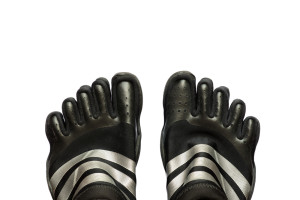 In the last few years, barefoot running has made a resurgence in popularity. Running shoes evolved through the last few decades to heavily favor cushioned heels. This enabled runners to land on their heels and roll their feet forward. While this allows you to lengthen your stride, it may not necessarily be for the better. To understand whether or not barefoot shoes are good for your feet, you must first understand how your feet work.
In the last few years, barefoot running has made a resurgence in popularity. Running shoes evolved through the last few decades to heavily favor cushioned heels. This enabled runners to land on their heels and roll their feet forward. While this allows you to lengthen your stride, it may not necessarily be for the better. To understand whether or not barefoot shoes are good for your feet, you must first understand how your feet work.
Foot Design
Each foot is composed of five long bones extending from the mid-foot to the end of your toes. These bones, or metatarsals, can move independently of each other and support your body weight and distribute the load evenly.
If you were to jump and land on the balls of your feet, the metatarsals would flex to distribute the weight and cushion your landing.
Present in most people’s feet, there is an arch at the mid-foot between the heel and the toes. An arch is one the strongest load bearing designs in architecture. It works by dispersing the weight evenly down either side of the arch.
Running Form
It is also beneficial to understand proper running form and how shoes can alter your movements. Form is important for many reasons, namely conservation of effort and injury prevention. To achieve good form, your upper body should be straight up and down. Your feet should strike directly underneath your body. This will shorten your stride, but that is a good thing. If your stride causes your left leg to strike out in front of your body, your stride is too long.
Shoe Design
Shoes are designed with a specific heel-toe differential. This is simply the distance between your heel and ball of your foot to the ground. Shoes with more cushioning under the heel have a higher differential. Barefoot shoes have a zero differential.
Cushioned shoes with a higher offset enable your heel to strike the ground first and your stride to be longer. While this may sound like a good thing, it may not be.
Once your stride lengthens and your heel hits the ground instead of your forefoot, you’re expending more energy than necessary. And you’re opening yourself up to common running injuries. Without allowing your foot to work as it should, you are weakening it over time. Without a cushioned heel, barefoot shoes promote proper running form as striking with your heel will be uncomfortable and painful.
Conclusion
To test these ideas, go outside barefoot and run a few steps. Your natural stride will be very close to the proper running form. Landing on your heel without wearing cushioned shoes causes pain and you will automatically adjust your stride to be shorter and land on the balls of your feet.
Whether you are an avid runner or a beginner, this will not be an easy change to make. The first few times using barefoot shoes will likely cause soreness in your calf muscles. They are doing the work normally done by your upper legs. Barefoot shoes, such as ones with individual toes, are not the only type out there. Many companies have their own line of minimalist shoes that are quite similar.
Barefoot or minimalist running is not for everyone. While it supports a more natural running form, its not for everyone. Humans evolved as runners, but we didn’t evolve with shoes.


